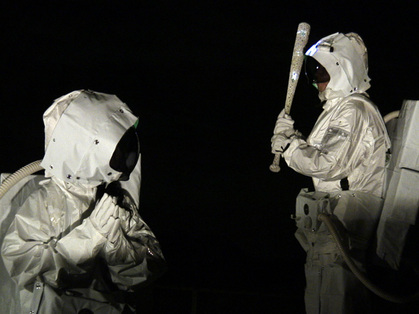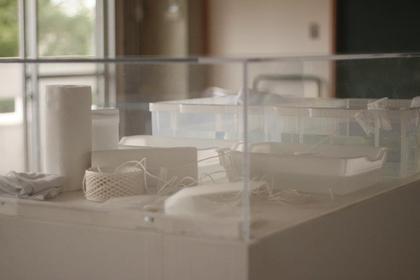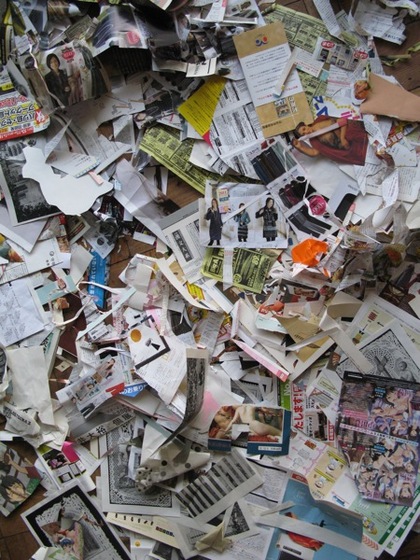
R
E
V N
E
X
T
Arcus Project is Japan’s longest running international artist-in-residence program, active since 1994, located in a repurposed school in the city of Moriya, Ibaraki Prefecture. Artists are invited to spend time on location, developing work which responds to and communicates with the local community and environment, culminating in a weekend-long “Open Studio” event.
Since the earthquake of March 11, 2011 however, Moriya also has the distinction of being a radiation “hot spot,” having registered higher than average levels—higher than some areas geographically closer to the damaged Fukushima nuclear reactors further north.
In this Blog project ArtAsiaPacific invited last year’s three resident artists—Hui Wai Keung from Hong Kong, Fazal Rizvi from Pakistan and Wojciech Gilewicz from Poland—to present their projects and reflect on being the first to complete their three-month residencies since the earthquake.
Wai, who applied after the quake, adapted his interest in technology and cosmology to the particular circumstances the area finds itself in, creating a somewhat whimsical performance based on reclaiming utopia from scientific reason. Rizvi, trained and based in Pakistan as a painter, found his original project—a series of paintings based on the experience of living with a local family—completely redirected by the circumstances he encountered after arriving, leading him to make installations and a symbolic “fire burial” for photographic mementos damaged in the tsunami stricken areas of the Tohoku (“northeast”) area. For Gilewicz, who had applied before the earthquake, he continued to focus on an encounter with Japan in general, responding to the city and visual ephemera he gleaned from everyday life, in a book of collages and a video.
Performance documentation for Emotional Experiment, from HUI WAI KEUNG’s project “Toro Nagashi in Outer Space,” 2011. Courtesy the artist.
Installation view of FAZAL RIZVI’s exhibition for “Open Studio,” Arcus Studio, Moriya, 2011. Courtesy the artist.
Hui Wai Keung
Hui has a background in computing as well as art. Many of his conceptual installations and performances explore relationships between the real, the virtual, the utopian and imaginary.
Hui’s main Arcus project, titled “Toro Nagashi in Outer Space,” aims to launch Japanese paper lanterns into space—a proposal for which will be submitted in coming years to the Japan Aerospace Exploration Agency (JAXA), incidentally located not far from Moriya.
Toro nagashi is a Japanese tradition, where people float paper lanterns with candles inside down a river, believing that the lanterns will guide the spirits of the departed back to the “other world,” located at the end of the sea. However, nowadays, this “end of the sea” concept has been lost because science has demonstrated that the earth is a sphere and therefore the sea has no end. Hui’s proposal updates the story, re-locating the “other world” to the end of the universe.
Hui says: “This new version could reconstruct a physical utopia in our imagination, as well as a physical relationship with our ancestors.”
In his performance piece “Emotional experiment” Hui assembled a team of would-be scientists and astronauts, portraying the scenario of sending toro nagashi into outer space. From the moon, floating lanterns are hit away with a specially made bat, needing a swing powerful enough to send them into deep space.
In another project, Hui rewrote the city’s “Citizen Charter” into actionscript programming language, which was then written onto 800 individual, freshly backed cookies with the help of local participants. These were later served for the Open Studio, and for Hui represent the “execution” (in the sense of activation) of the charter’s computer code in the body.
Fazal Rizvi
“My work seems to have started at one point and is ending with that. It began with the volunteering at the photo cleaning project in Kichijoji [Tokyo], where they were cleaning the albums that got destroyed in the Tsunami affected areas. I had initially thought that I could just go to this place and get some images/picture to work with and paint. But I could not get myself to use someone’s pictures in my work without their consent especially when they had been through so much. Thus working with material of such a nature I became extremely conscious of how much of it to work with and that somehow became one of the primary concerns. Once they were taking out the pictures from the albums, the damaged albums were of no use and they were throwing them away. I brought these remains of the albums back with me to the studio in Moriya to work with.
Also the effect radiation has had on life in Japan, inevitably ended up affecting my work directly and as an artist I could not help but react to these situations. I wanted to organise the photo cleaning workshop in Moriya as I felt it was a very important cause to conserve and save people’s memories. But the Arcus Project Administration Committee suspected that the albums that might come from a certain area might contain radiation. And thus I was not allowed to do the workshop. So I made an installation in protest for the second Open Studio. I got all the tools that I needed for the cleaning workshop and put them in an organised way under a museum case. Unused and inaccessible. All in white. My Silent Protest.
There was another rather humble installation of paintings and two books, hinting at the radiation scare.
Throughout these situations I found myself questioning a lot of things, basic ideas about art and art making. Those concerns—and all that happened with my projects at Arcus that was questionable—I brought them up in a series of letters to my mother titled “These are not love letters.”
And where my work began with the remains of the albums it eventually found an ending with those too. I was perplexed as to what to do with them before I leave; I could not take all of them away, nor did I want to throw them away, as trash. So I organised a funeral ceremony on the final Open Studio where the remains were cremated."
Wojciech Gilewicz
While in Moriya Gilewicz presented a draft of a book which consists of dozens of image combinations, within the framework of “Recycling Culture” collecting images and trying to find potential connections between them giving the impression that we are all living in “visual trash,” as he calls it, where all images and ideas are recyclable and reusable in new and endless contexts. He also worked on a video reflecting on life in the city.
Artist statement:
“Collage as an art technique is basically about putting different materials, such as paper, plastic, rope, glue etc.—the possibilities are endless—together into one new whole. The first who used it in art however were Braque and Picasso at the beginning of the 20th century.
After many years collage still seems very fresh and is even gaining more popularity nowadays amongst artists coming from different visual cultures, and attracts recognition from the public and critics alike.
What is so fascinating about cutting out fragments of existing photographs or other images and putting them into one new work of art, with a different style and meaning? Is our modern culture in some way actually similar to that seemingly simple process? Is our modern life recyclable like all of these existing images, to be used again and again?
The photos used for this collage project realized in Arcus were taken from the internet. These are a mixture of my own combinations, and some realized during workshops I conducted at Arcus, as well as quite random ones made out of junk laying on a pile of paper scraps in the studio where I worked.”
ArtAsiaPacific would like to thank Cecilia Ramirez Corzo Robledo, formerly at Arcus Studio, for her assistance in initiating this Blog project.








